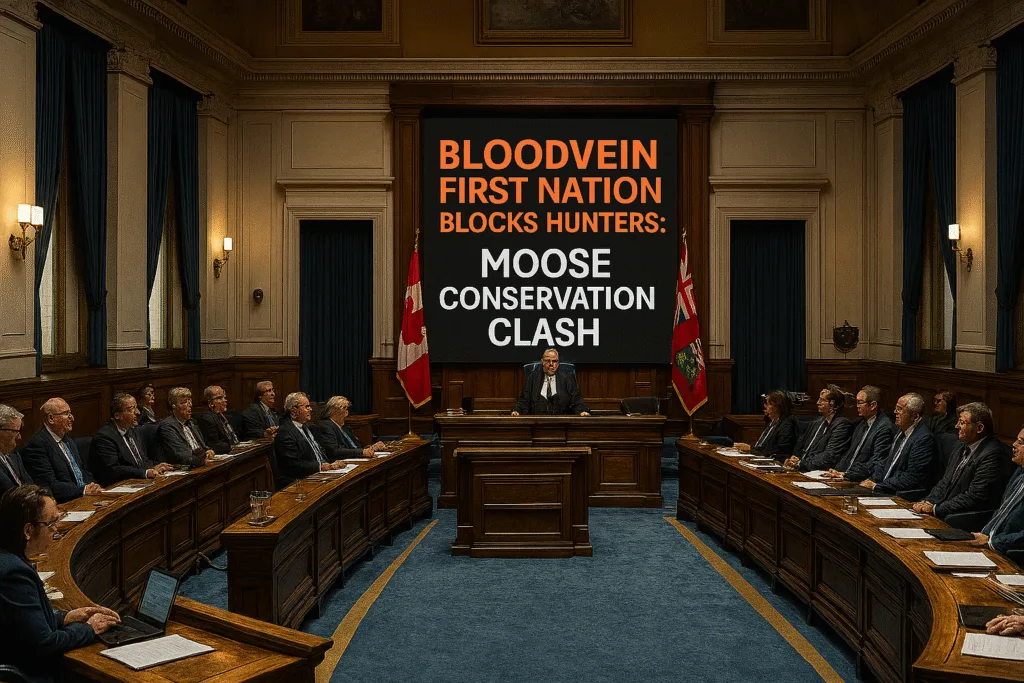
Indigenous Land Rights, Wildlife Conservation, and Policy Clash in Eastern Manitoba
The 2025 moose hunting season in Manitoba has erupted into a high-stakes standoff between Indigenous sovereignty and provincial wildlife policy. This situation is playing out in the context of the newly established Manitoba hunting buffer zone 2025. On September 14, Bloodvein First Nation took direct action by blocking non-Indigenous hunters from entering their traditional territory near Rice River Road, citing declining moose populations and disrespectful hunting practices.
In response, the Manitoba government announced a temporary hunting buffer zone across Game Hunting Areas (GHAs) 17, 17A, and 17B, marking a pivotal moment in land governance and conservation strategy.
What Is the Manitoba Hunting Buffer Zone 2025?
The Manitoba hunting buffer zone 2025 is a newly established no-hunting corridor designed to protect moose populations and uphold Indigenous stewardship. It includes:
- 📍 A 500-metre buffer on either side of Rice River Road, Bloodvein River, and Namay Falls
- 🗓️ Enforcement for the 2025 hunting season only
- 🦌 Aimed at moose conservation and conflict de-escalation
- 👮 Monitored by Manitoba Conservation Officers and community safety teams
This buffer zone directly affects licensed hunters who received one of the 175 moose tags issued for the region. Many now find their hunting plans disrupted or invalidated.
Bloodvein First Nation’s Role in Shaping the Manitoba Hunting Buffer Zone 2025
The buffer zone was not the result of a provincial wildlife study or stakeholder roundtable. It was triggered by grassroots Indigenous action.
Bloodvein First Nation leaders, frustrated by years of declining moose numbers and lack of consultation, set up a roadside checkstop to block access to their lands. Their goal: protect the land, the animals, and their rights.
“We’ve seen outsiders take antlers and leave carcasses,” said one Bloodvein elder. “This is our land. We’re done watching it be disrespected.”
The province responded within 48 hours, amending the Wildlife Act and creating the buffer zone — a move that has sparked both praise and outrage.
Hunter Reactions to the Manitoba Hunting Buffer Zone 2025
The announcement has ignited backlash among Manitoba’s hunting community. Chris Heald, Executive Director of the Manitoba Wildlife Federation, criticized the province’s decision, calling it “a terrible precedent.”
“There was no consultation, no science, and no transparency,” Heald told CBC News. “This undermines decades of collaborative wildlife management.”
Hunters are demanding clarity, refunds, and accountability. Many had planned trips around GHAs 17–17B, only to find their access restricted. Outfitters and rural communities reliant on seasonal hunting income are also voicing concern.
Conservation and Indigenous Stewardship Behind the Manitoba Hunting Buffer Zone 2025
The buffer zone highlights a growing divide between traditional conservation models and Indigenous-led stewardship. Moose populations in eastern Manitoba have declined sharply, with some areas reporting drops of over 60%.
Bloodvein First Nation argues that provincial policies have failed to protect wildlife and ignored Indigenous knowledge systems. The buffer zone is their response — a temporary but symbolic assertion of ecological responsibility.
This moment reflects a broader shift toward co-management of wildlife resources, where Indigenous communities play a central role in decision-making.
Legal and Political Implications
The buffer zone raises complex legal questions. While provinces typically regulate wildlife, Indigenous communities have constitutionally protected rights to manage their traditional territories.
By creating the buffer zone, Manitoba may be attempting to avoid legal conflict — but it also risks setting a precedent for future land-use disputes. Legal experts suggest this case could influence policy across Canada, especially in regions with overlapping jurisdictional claims.
“This is a test case,” said one analyst. “It challenges the boundaries of provincial authority and affirms Indigenous governance.”
Public Sentiment and Online Reaction
The buffer zone has gone viral across social media platforms. On TikTok, videos of the Bloodvein blockade have racked up thousands of views, with hashtags like #BufferZone2025, #MooseJustice, and #BloodveinStrong trending nationwide.
On Reddit and X (formerly Twitter), users are divided:
- “Respect to Bloodvein for protecting the land. The moose need defenders.”
- “This is government overreach. Hunters deserve better.”
- “Indigenous sovereignty isn’t optional. It’s law.”
The debate reflects deep tensions around land access, conservation ethics, and Indigenous rights — all amplified by digital platforms.
What Happens After the Manitoba Hunting Buffer Zone 2025 Expires?

The buffer zone is temporary, set to expire at the end of the 2025 hunting season. But Bloodvein First Nation has made it clear: unless meaningful consultation and co-management are established, they may continue to restrict access.
The province now faces pressure to develop a long-term strategy that balances:
- 🧭 Indigenous land rights
- 🦌 Wildlife conservation
- 🧑🌾 Hunter access and economic impact
- 📊 Transparent policy-making
Experts are calling for a collaborative wildlife governance model, integrating Indigenous knowledge with ecological science and stakeholder input.
Why the Manitoba Hunting Buffer Zone 2025 Is a Turning Point
The Manitoba hunting buffer zone 2025 is more than a seasonal restriction. It’s a symbol of shifting power dynamics in Canadian land management.
Bloodvein First Nation didn’t wait for permission — they acted. And now the province, hunters, conservationists, and the public must respond.
This moment demands attention. Whether you support Indigenous sovereignty, wildlife protection, or hunting access, the buffer zone represents a new chapter in how Canada negotiates land, rights, and responsibility.





















